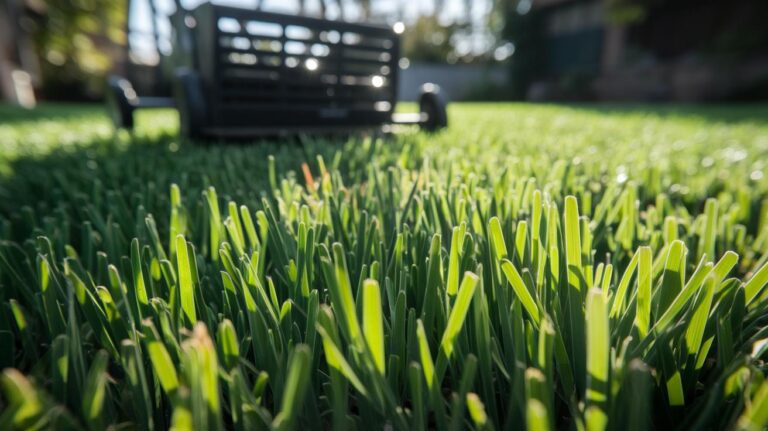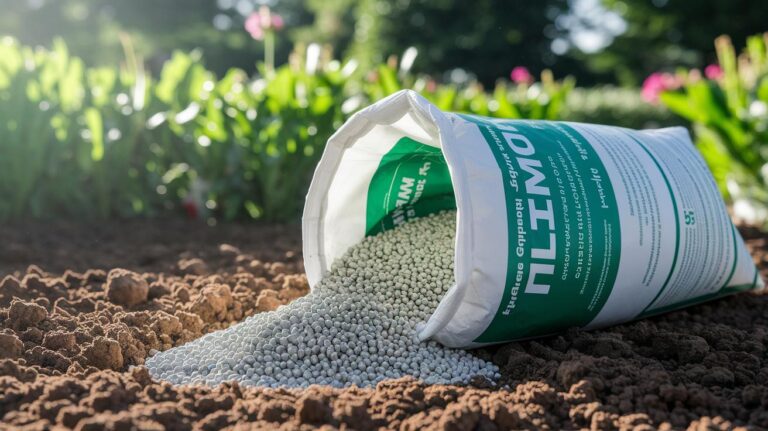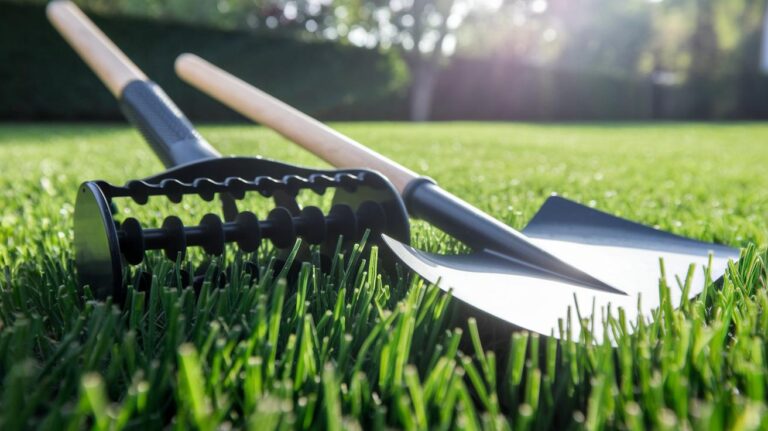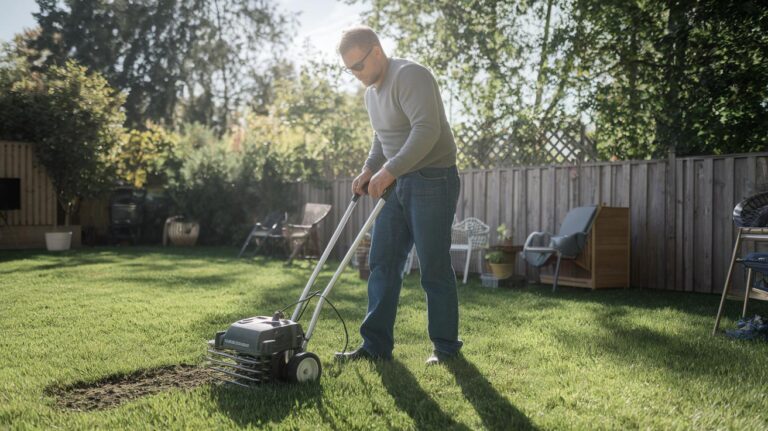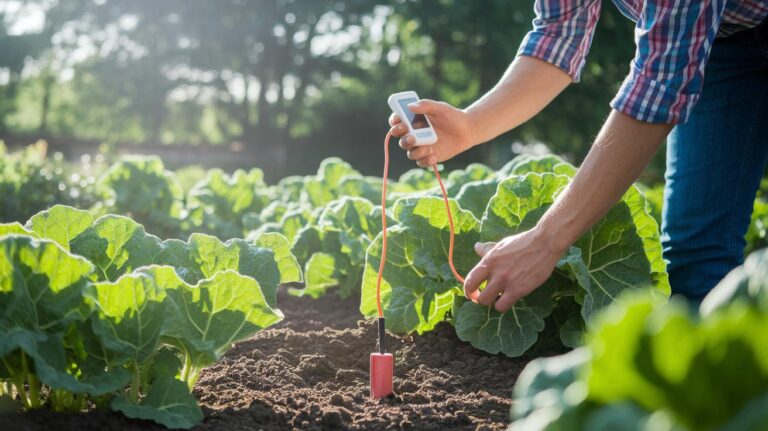Manual Lawn Aeration Promotes Healthy, Vibrant Grass
Have you ever wondered why your lawn still looks thin after a good watering? Sometimes the ground feels like a brick. Hard-packed soil (dirt pressed tight around roots) can leave grass gasping for air.
So I reach for my hand aerator (a handheld tool with skinny tines). Press it in, and you feel the warm earth crumbling between your fingers. It’s like poking tiny tunnels that let air, water, and nutrients dive deep.
You choose how deep the holes go and how far apart they are. No noisy machine needed. I always keep mine by the back door. It’s the first tool I grab when I notice bare spots.
Manual aeration gives grass room to breathe and stretch its roots. With those stronger roots, blades get thicker and greener. And bare spots start filling in.
Your lawn will thank you.
Essential Techniques and Benefits of Manual Lawn Aeration
Manual lawn aeration helps break up compaction (when soil packs too tight for roots). It’s like giving your grass tiny breathing tubes – letting air, water, and nutrients sink deep. When you grab a hand aerator, you decide how deep and how far apart each hole goes. Have you ever felt the cool earth give way under your feet?
Spike aeration punches narrow holes a few centimeters deep. Hollow-tine aeration (removing 2-4-inch soil plugs) pulls out small cylinders of earth. Don’t mix up core aeration vs spike aeration – both help soil breathe if you use them right. And oops, sometimes I poke my finger instead of the soil.
Make two passes at right angles in a crosshatch pattern. You’ll land about 20-40 holes every square foot, marking the ground like a street grid. This really cuts down soil compaction by creating air pockets. Your lawn will breathe easier, right?
Here are the top lawn aeration benefits:
- Improved root growth (roots stretch deeper).
- Better water infiltration (rain and hose water soak in).
- Enhanced nutrient uptake (feed reaches roots).
- Reduced soil compaction (air pockets let roots breathe).
- Superior drainage (extra water drains away).
- More effective weed control (thatch loosens, weeds weaken).
Those little soil plugs look odd at first. But they crumble on their own, returning organic matter (decayed bits that feed grass) right where it’s needed. Over the season, you’ll see greener blades and fewer bare spots. I once tried a machine aerator, but using my own hands felt more rewarding.
Seeing those tiny holes ring your yard makes the work worthwhile.
Essential Tools and Equipment for Manual Lawn Aeration
Ever stomp on the ground in your yard and feel it’s as hard as a brick? That’s compacted soil begging for air. To fix that, you need the right hand aerator tools. Manual core aerator (tool that pulls out little soil plugs) pries out plugs so roots can breathe, fresh air for your roots.
Spike aerators (tools with spikes that punch holes) are great for a quick job. You know, they’re simple but effective. Aerator shoes (shoes with spikes) slip over your boots and let you aerate while you walk. And for tight corners or small patches, grab a sturdy spading fork (long-handled garden fork for digging) and wiggle it in to fluff the earth.
Pick tools with stainless-steel tines (prongs) at least 5 cm long, non-slip footplates, comfy soft-grip handles, and balanced weight that won’t tire you out. Your back will thank you. Oops, almost forgot. Rust-resistant tines mean a tool that lasts.
Here are two of my favorites:
| Tool | Tine Length | Handle | Notes |
|---|---|---|---|
| Kent & Stowe Core Aerator | 9 cm | FSC ash wood | Soft-grip, ergonomic feel |
| Greenkey Rolling Drum | 30 cm drum | Adjustable steel shaft | Ideal for larger yards |
I love how the Kent & Stowe digs deep without weighing you down. And the Greenkey drum rolls smoothly so big lawns get done fast.
Mix techniques for tricky spots: start with aerator shoes, then finish with your spading fork for extra precision. You’ll see new grass growth quicker that way. For a full side-by-side tool comparison, check out tools for lawn aeration.
Manual Lawn Aeration Promotes Healthy, Vibrant Grass

So, you want some lush grass? It starts with simple prep. Mow your lawn to about 2 or 3 inches high. Then water until the top inch of soil feels damp (the earth should be soft enough to press in with your finger).
Before you start poking holes, take a slow walk around. Flag any hidden sprinkler heads, shallow lines, or wires. This way you won’t hit a pipe or cable and you’ll know where to work safely.
If your lawn is only a bit firm, one pass is enough. But for old, tightly packed turf, try a crosshatch pattern. Push the fork down firmly, then pull straight up and listen for that satisfying pop as a soil plug comes out.
Aim for about 20 to 40 holes in each square foot. Think of each hole as a tiny tunnel for air, water, and nutrients to reach the roots. Your grass will grow stronger and greener.
Overlap each row by half your tool’s width. Keep steady pressure as you move. Oops, I sometimes jab too deep, just smooth over the spot with a bit of loose soil. That’s it. Grab a simple lawn fork or a hand aerator and get started. Your grass will love the extra breathing room.
Timing and Frequency for Effective Manual Lawn Aeration
Picking the right day is huge. Manual aeration (making tiny holes so air, water, and nutrients sink into the soil) works best when the ground is cool and a bit damp.
For cool-season grasses like fescue or Kentucky bluegrass, early fall is perfect. The soil still feels warm under your feet but the air is crisp. You’ll notice the holes fill in nicely before winter. You can also aerate in early spring, just watch those new green shoots. They can slow you down if you wait too late.
Warm-season grasses such as Bermuda or Zoysia shine with late spring to early summer aeration. Their heat-loving roots jump into fresh holes before the summer sun turns up the dial. Wait too long, though, and drought stress might make your grass sulk.
Soil type matters a lot. Clay soils (dense dirt that packs tight) need aeration every year so grass roots can stretch deeper. Sandy soils (loose, quick-draining dirt) usually only ask for it every one to two years. And if you live somewhere dry, aerating in both spring and fall can stop turf from curling up under a hot sun.
If your lawn sees a lot of foot or vehicle traffic, it’s asking for annual aeration to shake off compaction (when dirt gets squished so roots can’t breathe). By the way, check out our fall lawn aeration guide to match timing with your local weather. And for spring chores, our best time for lawn aeration shows how cool mornings and recent rain set you up for success.
Manual Lawn Aeration Promotes Healthy, Vibrant Grass
After you poke those tiny tunnels (aeration means making small holes in the soil), leave the little soil plugs (bits of earth) right where they dropped. Let them dry in the sun and then gently rake to crumble them back into the warm earth. It’s best to pull or treat weeds before aerating so you’re not spreading their seeds all over. You’ll see how feeding fresh roots with a slow-release plant food (fertilizer) after aeration sets the scene for stronger, greener blades.
And when those holes are open, overseeding (adding grass seed) is a breeze. Scatter seed over thin spots and bare patches, then press it lightly into each pocket. Follow up with careful watering, just enough to moisten the soil without washing seeds away.
- Leave soil plugs (bits of earth) in place so they break down naturally. Once they’re dry, give a light rake to spread rich organic bits.
- Weed control: pull or spray weeds beforehand so you don’t spread seeds during aeration.
- Post-aeration fertilizing (plant food): spread a balanced, slow-release lawn food right after aeration to feed roots deep below.
- Overseeding (adding grass seed): sprinkle seed across sparse zones and press gently into the holes.
- Compost topdressing (decayed organic matter): fill each hole with a thin ¼” layer of compost or coarse sand to nourish new roots.
- Watering after aeration: give a gentle first soak. Then water more often in hot or dry weather to keep soil damp but not soggy.
- Surface topdressing (smoothing soil): run a fine soil mix over the lawn to level it and tuck in fresh seed.
Keep foot traffic light for at least two weeks so new roots can anchor snugly. Each mow will help settle topdressing, and before you know it, those bare spots will pop with green growth.
Comparing Manual Aeration with Alternative Methods

Manual aeration (making small holes in soil so air, water, and nutrients sink deep) costs almost nothing and treats your lawn gently. It feels like pressing your fingers into warm earth, giving thirsty roots room to grow. Have you ever heard the soft pop of a soil plug coming out?
Aeration vs dethatching? Good question. Dethatching (raking away dead grass and moss) only lifts old debris, like combing out hair. But aeration breaks up thatch and lets the soil underneath loosen and breathe.
You might wonder: electric vs manual aeration? Gas or electric machines dig deeper and stitch through soil faster than you can push a hand tool. But a rented aerator usually needs a truck or trailer to haul it home. I learned that the hard way last spring!
Beware spike aerators. Their solid prongs can actually pack soil tighter around the holes, undoing your hard work. A hollow-tine core aerator (tool that pulls out little plugs of soil) is gentler and really lifts plugs away. After each pass, brush off those removed soil plugs.
When you’re done, give your tines a good wipe. A quick scrub to remove leftover soil and letting parts air-dry helps them last. If you have a minute, sharpen the tines before storing. Tuck your hand aerator in a dry spot so it won’t rust. Next aeration day will feel like a fresh start.
Final Words
In the action of punching holes and watching soil breathe, you’ve seen how manual lawn aeration fights compaction and lets water sink in.
Next we chose the right hand tools, spike or core tines, so you can tackle your yard without renting big machines.
Then came the step-by-step plan: prep, crosshatch passes, timing for your grass, and simple feeding and watering tips.
We even compared powered gear to your own effort.
Here’s to a thicker, greener lawn ahead with manual lawn aeration.
FAQ
Do manual lawn aerators work?
Manual lawn aerators work by punching or coring holes to ease soil compaction and boost water, air, and nutrient flow for stronger roots and healthier turf.
Can I manually aerate my lawn?
You can manually aerate your lawn using a garden fork, spike aerator shoes, or handheld core tool when soil is moist, creating holes that help roots and water reach deeper.
How far apart should you manually aerate?
When you manually aerate, space holes about 2 to 3 inches apart in a crosshatch pattern, creating roughly 20 to 40 holes per square foot for even soil relief.
What is the best cheapest way to aerate a lawn?
The cheapest way to aerate is to rent a manual core aerator for about $40 per day or use a simple garden fork or spike aerator shoes you likely already own.
What is the best manual lawn aerator tool?
The best manual aerator tool is a hollow-tine core aerator with sturdy steel tines and a soft-grip handle for easy pressure and plug removal in small to medium yards.
How much does manual lawn aeration cost?
Buying a manual aerator runs $30 to $150, while renting a core aerator costs around $40 to $60 per day, depending on tool type and local rates.


